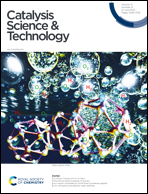Low-temperature deep oxidation of N,N-dimethylformamide (DMF) over CeCu binary oxides†
Abstract
A binary oxide of ceria–copper was fabricated via the sol–gel technique for converting N,N-dimethylformamide (DMF) to harmless gases. The structure-chemical morphology, redox properties and bandgap energies of the synthesized oxides were comprehensively analyzed using XRD, BET, TEM, HRTEM, EDS-HAADF, XPS, TPR/TPO and UV-vis. XRD and BET spectra reveal that the increment in Cu content reduces the crystallite size and increases the pore volume of the nanopowder catalysts. The difference in OLat, Cu2+/Cu+, and Ce3+/Ce4+ at the surface with Cu loading significantly affects the catalytic activity. The TPR/TPO results indicate that doping CeOx with Cu improved the redox properties at lower temperatures. The incorporation of Cu shifts the light-off curves towards low temperatures. According to the XPS results, the increased catalytic performance and stability are ascribed to the oxygen vacancies' abundance in the doped oxides. Ce10Cu90 binary oxide unveiled the best DMF conversion of ∼98% because of its low Ea and Eg, as well as the largest amount of Cu2+, and Ce3+ species. A proposed mechanism was developed to explain the decomposition of DMF to produce NO2 and CO2. These findings suggest that Ce10Cu90 is an efficient and stable catalyst for industrial applications.



 Please wait while we load your content...
Please wait while we load your content...